Life Mathematics | Chapter 4 | 8th Maths - Compound Variation | 8th Maths : Chapter 4 : Life Mathematics
Chapter: 8th Maths : Chapter 4 : Life Mathematics
Compound Variation
Compound
Variation
Before we
could learn about compound variation, let us recall the concepts on direct and inverse
proportions.
If two quantities
are such that an increase or decrease in one quantity makes a corresponding increase
or decrease (same effect) in the other quantity, then they are said to be in direct
proportion or said to vary directly. In other words, x and y are said to vary directly
if y=kx always, where k is called the proportionality constant and k > 0 assuming that y depends
on x and so k
=
y/x.
For example,
let us assume that one of you plan to give 2 pens to each of your friends in the
birthday party. Then the number of pens to be bought will be in direct proportion
with the number of friends who will attend the party. Isn’t it? The following table
will help you understand this clearly.

In this case, we find that the proportionality constant, k = y/x = 2/1 = 4/2 = 10/5 = 24/12 = 30/15 = 2 .
Few more examples of Direct Proportion:
1. Distance –Time (under constant speed): If the distance increases,
then the time taken to reach that distance will also increase and vice- versa.
2. Purchase – Spending: If the purchase on utilities for a family during the festival time increases, then the spending
limit also increases and vice versa.
3. WorkTime – Earnings: If the number of hours worked is less, then the pay earned will also be less and vice-versa.
Similarly,
if two quantities are such that an increase or decrease in one quantity makes a
corresponding decrease or increase (opposite effect) in the other quantity, then
they are said to be in inverse (indirect) proportion or said to vary inversely.
In other words, x and y are said to vary inversely, if xy = k always, where k is called proportionality constant and k > 0.
For example,
let us assume that a class of 30 students in a school walks on streets in a village
for health awareness campaign in an orderly manner, then we can see an inverse proportion
in the number of rows and columns they walk. The following table will help you understand
this clearly.

We can map
a few of these arrangements as  (5 rows/6 columns)and
(5 rows/6 columns)and ![]() (6
rows/5 columns) and see the opposite variations in rows and columns.
(6
rows/5 columns) and see the opposite variations in rows and columns.
In this case,
we find that the proportionality constant, k
is 30.
Few more examples of Inverse Proportion:
1. Price – Consumption: If the price of consumable products increases, then naturally its consumption will decrease
and vice-versa.
2. Workers – Time: If more workers are employed to complete a work, then the time taken to complete the work
will be less and vice-versa.
3. Speed – Time (Fixed Distance): If we travel with less speed, then the time taken
to cover a given distance will
be more and vice-versa.
Now, use
the concept of direct and inverse proportions and try to answer the following questions:
Try these
1. Classify the given examples as direct or inverse proportion:
(i) Weight of pulses to their cost.
Answer:
As weight increases cost also increases.
∴ Weight and cost are direct proportion.
(ii) Distance travelled by bus to the price of ticket.
Answer:
As the distance increases price to travel also increases.
∴ Distance and price are direct proportion.
(iii) Speed of the athelete to cover a certain distance.
Answer:
As the speed increases, the time to cover the distance become
less.
So speed and time are in indirect proportion.
(iv) Number of workers employed to complete a construction in a specified
time.
Answer:
As the number of workers increases, the amount of work become
less, so they are in indirect proportion.
(v) Area of a circle to its radius.
Answer:
If the radius of the circle increases its area also increases.
∴ Area and radius of
circles are direct proportion.
2. A student can type 21 pages in 15 minutes. At the same rate, how
long will it take the student to type 84 pages?
Solution:
Direct proportion
No. of minutes = x
k = 21/15
21/15 = 84/x
x = [84 × 15] / 21 = 60
3. If 35 women can do a piece of work in 16 days, in how many days
will 28 women do the same work?
Solution:
Inverse proportion
No. of days = x
k = 35 × 16
∴ 28 × x = 35 × 16
x = [ 35 × 16 ] / 28 = 20 days
Let us now
see what a Compound Variation is? There will be problems which may involve a chain
of two or more variations in them. This is called as Compound Variation.
The different
possibilities of two variations are:
Direct-Direct,
Direct-Inverse,
Inverse-Direct,
Inverse-Inverse.
Note
There are situations where neither direct proportion nor indirect
proportion can be applied. For example, if one can see a parrot at a distance through
one eye, it does not mean that he can see two parrots at the same distance through
both the eyes. Also, if it takes 5 minutes to fry a vadai, it does not mean that
it will take 100 minutes to fry 20 vadais!
Let us now
solve a few problems on compound variation. Here, we compare the known quantity
with the unknown (x). There are a few
methods in practice by which problems on compound variation are solved. They are
given as follows:
1. Proportion
Method
In this method,
we shall compare the given data and find whether they are in direct or inverse proportion.
By finding the proportion, we can use the fact that
the product of the extremes
= the product of the means
and get the
value of the unknown (x).
2. Multiplicative
Factor Method
Illustration:

Here, the
unknown (x) is in men and so it is compared
to the known, namely hours and days. If men and hours are in direct proportion (D), then
take the multiplying factor as d/c (take the reciprocal). Also, if men and
days are in inverse proportion ( I ), then take the multiplying factor as e/f (no change). Thus, we can find the unknown
(x) in men as x = a × d/c × e/f.
3. Formula
Method
Identify
the data from the given statement as Persons (P), Days (D), Hours (H) and Work (W)
and use the formula,

where the
suffix 1 contains the complete data from the first statement of the given problem
and the suffix 2 contains the unknown data to be found out in the second statement
of the problem. That is, this formula says, P1
men doing W1 units of work
in D1 days working H1 hours per day is the same as
P2 men doing W2 units of work in D2 days working H2 hours per day. Identifying
the work W1 and W2 correctly is more important
in these problems. This method will be easy for finding the unknown (x) quickly.
Example 4.19
(Direct – Direct Variation)
If a company
pays ₹6
lakh for 15 workers for 20 days, how much would it need to pay for 5 workers for
12 days?
Solution:
Proportion Method

Here, the
unknown is the pay (x). It is to be compared
with the workers and the days.
Step 1:
Here, less
days means less pay. So, it is in direct proportion.
∴
The proportion is 20 : 12 :: 6 : x ………1
Step 2:
Also, less
workers means less pay. So, it is in direct proportion again.
∴ The proportion is 15 : 5 :: 6 : x ………2
Step 3:

We know that,
the product of
the extremes = the product of the means

So, 20 ×15
× x = 12 ×6 × 5 ⇒ x =  = (12×6×5) / (20×15) = ₹ 1.2 lakh.
= (12×6×5) / (20×15) = ₹ 1.2 lakh.
Multiplicative Factor Method

Here, the
unknown is the pay (x). It is to be compared
with the workers and the days.
Step 1:
Here, less
days means less pay. So, it is in direct proportion.
The multiplying
factor is 12/20 (take the reciprocal).
Step 2:
Also, less
workers means less pay. So, it is in direct proportion again.
The multiplying
factor is 5/15 (take the reciprocal).
Step 3:
∴ x = 6 × 12/20 × 5/15 = ₹ 1.2 lakh.
Formula Method
Here, P1 =
15, D1 =
20 and W1 =
6 . Also, P2 =5, D2 = 12 and W2 = x
Using the
formula, [P1×D1] / W1= [P2×D2]
/ W2
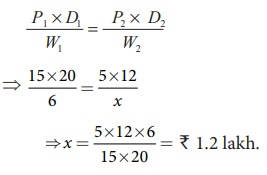
Example 4.20
(Direct – Inverse Variation)
A mat of
length 180 m is made by 15 women in 12 days. How long will it take for 32 women
to make a mat of length 512 m?

Solution:
Proportion Method

Here, the
unknown is the days (x). It is to be compared
with the length and the women.
Step 1:
Here, more
length means more days. So, it is in direct proportion.
∴ The proportion is 180 : 512 :: 12 : x ……………1
Step 2:
Also, more
women means less days. So, it is in inverse proportion.
∴ The proportion is 32 : 15 :: 12 : x ……………2
Step 3:

We know that,
the product of
the extremes = the product of the means

So, 180×
32 ×x = 512×12×15 ⇒ x
=
(512×12
×15)
/(180×32)
=16
days.
Multiplicative Factor Method

Here, the
unknown is the days (x). It is to be compared
with the length and the women.
Step 1:
Here, more
length means more days. So, it is in direct proportion.
The multiplying
factor is 512/180 (take the reciprocal).
Step 2:
Also, more
women means less days. So, it is in inverse proportion.
The multiplying factor is 15/32 (no change).
Step 3:
∴ x = 12 × 512/180 × 15/32 = 16 days.
Formula Method:
Here, P1 =
15, D1 =
12 and W1 =
180 and P2 =
32, D2 =
x and W2 = 512
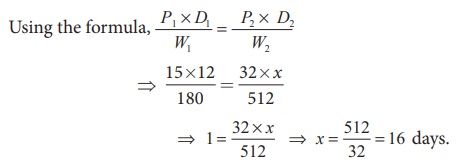
Remark: Students may answer in any
of the three given methods dealt here.
Try these
1. If x and y vary directly, find k when x = y = 5 .
Solution:
If x and y vary directly then x/y = k.
Here x = 5 ; y = 5
∴ k = 5/5
k = 1
2. If x and y vary inversely, find the constant of proportionality
when x = 64 and y = 0.75
Solution:
Given x = 64, y = 0.75 and also given x and
y vary inversely.
∴ xy = k. the constant of
variation.
∴ Constant = 64 × 0.75
Constant of variation = 48
Activity
Draw a circle of a given radius. Then, draw its radii in such a way
that the angles between any two consecutive pair of radii are equal. Start drawing
3 radii and end with drawing 12 radii in the circle. List and prepare a table for
the number of radii to the angle between a pair of consecutive radii and check whether
they are in inverse proportion. What is the proportionality constant?

Solution:

As the number of radii increases angle decreases.
Hence they are in inverse proportion
∴ xy = 4 proportional constant
3 × 120° = 360° = k = 360°
Example 4.21 (Inverse – Direct Variation)
If 81 students
can do a painting on a wall of length 448 m in 56 days, then how many students can
do the painting on a similar type of wall of length 160 m in 27 days?
Solution:
Multiplicative Factor Method

Here, the
unknown is the students (x). It is to
be compared with the days and the length of the wall.
Step 1:
Here, less
days means more students. So, it is in inverse proportion.
The multiplying factor is 56/27 .

Step 2:
Also, less
length means less students. So, it is in direct proportion.
The multiplying factor is 160/448.
Step 3:

∴ x = 81× (56/27) × (160/448)
x =
60 students.
Formula Method
Here, P1
= 81, D1 = 56 and W1 = 448 and P2 = x, D2
= 27 and W2 =160
Using the
formula, P1×D1 /W1 = P2× D2
/W2
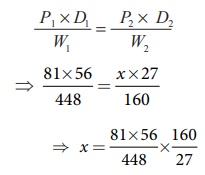
⇒ x = [(81×56)/448] × [160/27]
⇒ x = 60 students.
Example 4.22 (Inverse – Inverse Variation)
If 48 men
working 7 hours a day can do a work in 24 days, then in how many days will 28 men
working 8 hours a day can complete the same work?
Solution:
Multiplicative Factor Method

Here, the
unknown is the days (x). It is to be compared
with the men and the hours.
Step 1:
Here, less
men means more days. So, it is in inverse proportion.
The multiplying factor is 48/28.
Step 2:
Also, more
hours means less days. So, it is in inverse proportion again.
The multiplying factor is 7/8.
Step 3:
∴ x =  = 24 × (48/28) × (7/8) = 36 days.
= 24 × (48/28) × (7/8) = 36 days.
Formula Method
Here, P1 =
48, D1 =
24, H1 =
7 and W1 =
1 (Why?)
P2 = 28, D2 = x ,
H2 = 8 and W2 = 1 (Why?)
Using the
formula,
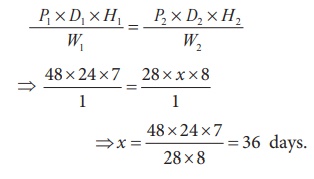
Try these
Identify the different variations present in the following questions:
1. 24 men can make 48 articles in 12 days. Then, 6 men can make _____
articles in 6 days.
Solution:
Let the required no. of articles be x

(i) Mens and days are Indirect variables.
(ii) Men and Articles are direct variables
(iii) Days and articles are also direct variables using formula.
Let P1 = 24 D1 = 12 W1 = 48
P2 = 6 D2
= 6 W2 = x
[ P1 × D1 ] / W1 = [P2
× D2] / W2
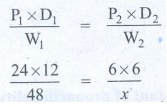
[24 × 12] / 48 = [6 × 6] / x
x = [ 6 × 6 × 48] / [24 × 12]
x = 6 Articles
2. 15 workers can lay a road of length 4 km in 4 hours. Then, _____
workers can lay a road of length 8 km in 8 hours.
Solution:
Let the required number of workers be x

(i) Length and workers are direct variable as more length need
more workers.
The proportion is 4 : 8 : : 15 : x ………..(1)
(ii) Hours and workers are indirect variables as more working
hours need less men.
∴ The proportion is 8 : 4 : : 15 : x ……..(2)
Combining (1) and (2)

Product of the extremes = Product of the means
4 × 8 × x = 8 × 4 × 15
x = [ 8 × 4 × 15 ] / [ 4 × 8 ]
x = 15 workers
3. 25 women working 12 hours a day can complete a work in 36 days.
Then, 20 women must work _____ hours a day to complete the same work in 30 days.
Solution:
Let the required hours be x.

As women increases hours to work decreases
∴ It is an inverse proportion.
∴ Multiplying factor is 25/20
As days increases hours needed become less
∴ It is also an indirect variation.
∴ Multiplying factor is 36/30
∴ x = 12 × [25/20] × [36/30]
x = 18 hours
4. In a camp there are 420 kg
of rice sufficient for 98 persons for 45 days. The number of days that 60 kg of rice will last for 42 persons is _____.
Solution:
Let the required number of days be x.

If amount of rice is more it will last for more days.
∴ It is Direct Proportion
∴ Multiplying factor is 60 / 420
If men increases number of days the rice lasts decreases
∴ It is an inverse proportion.
∴ Multiplying factor is 98 / 42
x = 45 × [60/420] × [98/42]
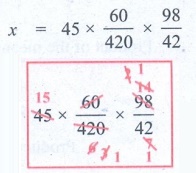
x = 15 days
Related Topics